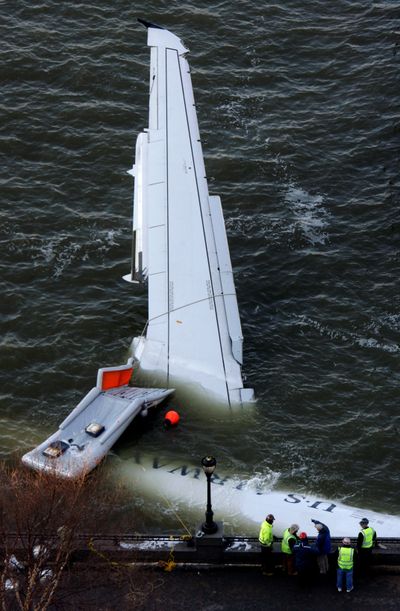Aviation safety at all-time high
No deaths in two years from airline accidents

The heroic actions of the pilots of a US Airways jet that ditched in the Hudson River in New York on Thursday highlighted what safety experts say is a broader trend in aviation: The system has never been so safe, and accidents have never been so survivable.
Crediting advances in technology, airplane design and training of pilots and flight attendants, experts say people are far more likely to survive accidents or avoid them altogether than at any time in the jet age. Fatal accident rates have plummeted in the past decade. In the past two years, not a single passenger on a U.S. commercial flight died in an accident, an unprecedented stretch. In 1995 and 1996, for example, nearly 500 passengers died in plane crashes.
“It’s getting to the point now where we can’t even pull up usable statistics because you are dividing into zero,” said Bill Voss, president of the Flight Safety Foundation, a nonprofit group that promotes aviation safety.
All 155 passengers survived Thursday’s crash of US Airways Flight 1549 after the crew glided the Charlotte-bound Airbus A320 to safety in the icy waters of the Hudson and expertly evacuated passengers to a flotilla of rescue boats. Friday, investigators from the National Transportation Safety Board began investigating why both engines of the plane failed, apparently after an encounter with a flock of birds within minutes of takeoff from LaGuardia Airport.
Harsh conditions in the river Friday impeded the search for the plane’s critical data and voice recorders, known as the black boxes, and for the missing engines.
Kitty Higgins, the NTSB member in charge of the on-scene investigation, said both engines are believed to have detached as the plane was pulled along by the river’s strong currents. The Port Authority of New York and New Jersey closed a section of the river until the engines are found.
Divers working with the NTSB attempted to reach the cockpit recorders in the tail end of the plane, but the work was made more difficult because the aircraft is almost completely submerged except for a wing and part of the tail.
An NTSB official said the river’s frigid temperatures, heavy currents and low visibility made it “treacherous” for divers. Workers this morning were expected to attempt to pull the entire aircraft frame from the water, then planned to carry it by barge to another location, where the investigation would continue.
“The hope is to be able to lift it out in one piece,” Higgins said.
The NTSB also hopes to begin discussions today with pilot Chesley B. “Sully” Sullenberger III and co-pilot Jeffrey Skiles, who are credited with calmly handling the crash and narrowly avoiding the populous areas of the Bronx and Midtown Manhattan.
Sullenberger considered making an emergency landing at a small New Jersey airport but decided to land on the water, according to two sources familiar with the investigation. Ditching is so rare that pilots don’t even practice it in sophisticated simulators.
But Sullenberger, an experienced pilot who also lectures on airline safety, apparently followed all of the theories and classroom training about how to do it correctly, said John Cox, a former US Airways pilot and former safety investigator of the Air Line Pilots Association. Sullenberger slowed the plane down, kept the plane’s nose up and allowed the jet to settle onto the water as gently as possible, he said.
Along with better pilot training, Voss and other experts point to a variety of trends for the increase in safety and survivability in accidents. Planes are being built to better withstand crashes and fires and technology has substantially improved, helping pilots avoid collisions with terrain and other aircraft. In the past, investigators improved safety by applying lessons learned from past crashes. With so few crashes today, investigators and regulators routinely seek clues to the next potential crash in mounds of information downloaded from devices that record thousands of data parameters on every flight.
In recent years, they said, the most high-profile accidents in the industrialized world have actually been the least deadly: Last month, every passenger managed to escape a burning Continental Airlines jet that skidded off a Denver runway. No one was killed when a British Airways jumbo-jet lost most of the power in both engines and slammed short of the runway of London’s bustling Heathrow Airport last January.
Even when an Air France jet careened off a Toronto runway four years ago and burst into flames, all of the plane’s 309 passengers escaped. Safety experts warned that the public should not become complacent about the aviation system. In all four examples they cited, the planes were destroyed. With only slight missteps, people may have died, they said.